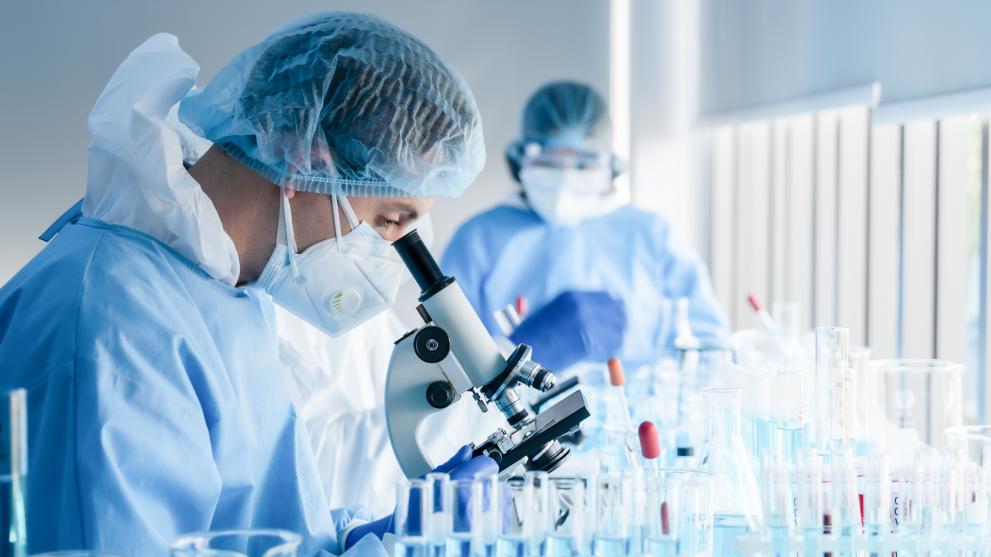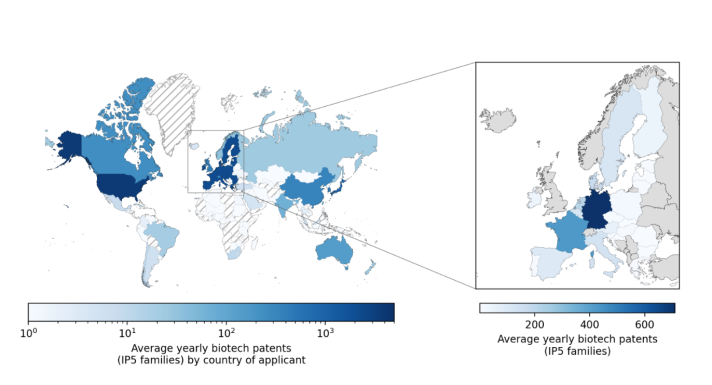
An analysis of the global landscape of biotechnology innovation shows that biotech patents represent about 5% of total patents filed between 2001 and 2020. The vast majority of the biotech patents is related to industrial and medical applications, combining more than 96% of all biotech patents analysed.
The US is leading in the development of biotech patents (39% of total biotech patents in 2020), followed by the EU with a 18% share and China advancing quickly (10% share).
The findings are published in a new JRC report that investigated innovative biotechnology developments in agriculture, industry, and medicine by looking into patenting activities in different countries over two decades.
The study supports the Commission’s initiative Building the future with nature: Boosting biotechnology and biomanufacturing in the EU, put forward today. It identifies the current challenges and barriers for biotechnology and biomanufacturing in the EU and proposes a series of targeted actions, contributing at the same time to the Union’s competitiveness.
JRC analysis relies on biotech patents filed at multiple offices
To identify the biotech patents, the JRC analysis relies on the European Patent Office’s EPO Patstat database. An additional layer of classification is the OECD selection of technological codes categorised as biotech.
The different biotechnologies are divided into agriculture-related (green biotech), industry-related (white biotech) and healthcare/pharma-related (red biotech). A fourth category is labelled horizontal biotech that includes biotechnologies that potentially have a transversal use.
Most of the biotech patents concern white (industrial) and red (medical) biotechnologies, combining more than 96% of all biotech patents analysed
Of all biotech patent families filed between 2001 and 2020, about 23.1% falls under the C12N category, defined by the World Intellectual Property Organization (WIPO) as encompassing "Micro-organisms or enzymes; compositions thereof; propagating, preserving, or maintaining micro-organisms; mutation or genetic engineering; culture media".
This category reflects the use of new or improved strains of microorganisms for fermentation of molecules. For example, while fermentation has been traditionally used to produce foodstuffs and beverages like bread, yogurt and beer, precision fermentation, which allows greater control on the process and the output, offers new possibilities.
The second most prominent technological category is C12Q, accounting for around 12.9% of all biotech patents. C12Q refers to "Measuring or testing processes involving enzymes or micro-organisms (immunoassay); compositions or test papers therefor; processes of preparing such compositions; condition-responsive control in microbiological or enzymological processes".
This category relates to the detection and diagnosis. For instance, it can be used to determine presence or kind of microorganism or the use of selective media for testing antibiotics or bacteriocides.
Both technologies are classified as white biotech and collectively account for over a third (36.1%) of all biotech patents filed worldwide during the observation period.
The third most patented biotechnology is A61K 38/00, categorised as red biotech, pertaining to "Medicinal preparations containing peptides". This category accounts for 11.9% of all biotech patents filed.
Different countries seem to have different specialisation patterns…
Japanese and Chinese applicants show relatively high specialisation in white biotech patents, while UK and US applicants are relatively specialised in red biotech patents. While the EU as a single region does not appear to be specialised in a specific biotechnology, at Member State level Germany and Denmark are specialised in white biotech, France and Italy in red biotech, and the Netherlands in green biotech.
Germany and France have the highest number of biotech patent applicants in the EU, accounting for over half of all EU biotech patents.
The single biotechnology most patented falls under the C12Q 1/68 category "Measuring or testing processes involving nucleic acids", which alone represents 5.7% of all the biotech patents analysed. Nucleic acids are large biomolecules that play essential roles in all cells and viruses and involve as a major function the storage and expression of genomic information.
…although they all develop similar biotechnologies
Interestingly, the three main biotechnologies in terms of share of patents are the same for the US, the EU, China, and the UK.
This seems to suggest that the competition among major players in biotech patents revolves around the number of patents in each of the main biotechnological domains, rather than the different types of biotechnologies patented.
Related content
Exploring the global landscape of biotech Innovation: preliminary insights from patent analysis
EC press release Commission takes action to boost biotechnology and biomanufacturing in the EU
Details
- Publication date
- 20 March 2024
- Author
- Joint Research Centre





